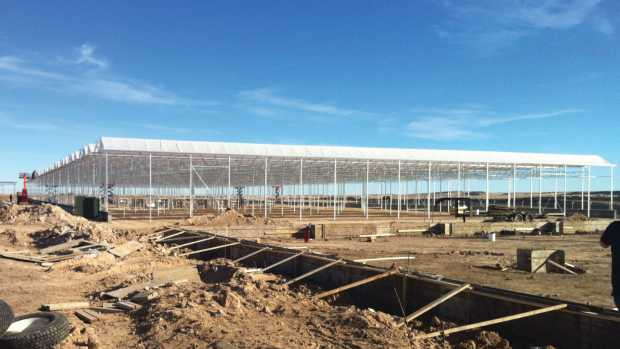Greenhouses Are More Efficient For Marijuana Production

GrowCo builds and finances greenhouses, and leases them to legally licensed cannabis growers in Colorado.
Updated May 28, 2015
Marijuana may well be the next big frontier for greenhouse growers. Cannabis growers and advisors are starting to move production out of the warehouse and into the greenhouse, to benefit from the efficiencies that the sun’s natural light and environmental controls provide.
In Colorado, Tim Beall, chief operating officer of GrowCo, a Denver-based company that builds and finances greenhouses, and then leases them to legally licensed cannabis growers, is helping growers make the transition from indoor growing to an environmentally controlled structure.
It’s a way, he says, to make production more cost-efficient for growers supplying Colorado’s ever-expanding recreational cannabis market. The state’s Marijuana Enforcement Division estimates that residents and visitors 21 and over consumed 130.3 metric tons of marijuana in 2014, with only 77 metric tons supplied by legal producers. However, growers are also subject to high taxes: A combination of state and county taxes in Denver add up to a 29 percent tax rate.
Greenhouse Structures Offer Energy Savings And Production Efficiencies
Beall, a former greenhouse vegetable grower who used to be chief financial officer for Sunblest Farms, Rocky Mountain Growers and Cherry Creek Systems, is well-acclimated to the benefits growing in a controlled environment offer. He says there are three main reasons to take cannabis to the greenhouse: significant energy savings, a much faster rate of plant metabolism and the advantage of natural physics.
The energy savings is the biggest attraction — a greenhouse is going to use only about a quarter of the energy used in a warehouse, he says. In addition to getting natural sunlight for free in a greenhouse, versus using artificial lighting, warehouse growers would save on the high electricity bills they currently incur by running air conditioning units, even in winter, to offset the heat given off by the lights.
“In a greenhouse, though, the only time I would add light is the times of the year when I probably need to heat the greenhouse anyway,” Beall says. “So that light for them is basically worse than 25 percent efficient, because 75 percent is the heat that they end up having to pay for air conditioning to get rid of, whereas in a greenhouse, that light becomes 100 percent efficient to me because I need that heat.”
Photosynthesis is also double in a greenhouse versus indoor facilities, allowing for faster plant growth rate and optimum plant health, Beall says.
“Think of it this way: Your average indoor grower is going to put in 500 to 600 micromoles of light, but in Colorado, we can get up upwards of 1,500 to 2000 micromoles of light in a greenhouse,” Beall says. “Now, can an indoor guy put in 1,500 to 2,000 micromoles of artificial lighting? Sure, but he’s not going to get the same growth rate out of that. Maybe if he put in LED, HPS, metal halide and something else, he’d come close to meeting that full spectrum of the sun. But studies over the years have shown that light from the sun is 30 percent more efficient for photosynthesis than artificial light.”
Humidity is another problem in warehouses, where growers have to run humidifiers, adding to the already high electricity usage. With their flat ceilings and insulated walls and ceilings, warehouses keep in moisture and heat, compared to the high peaks in a greenhouse, which naturally allow hot air to rise. With vents at the top, as in high-peak, open-roof greenhouses, the heat and moisture can easily escape.
“Inside the warehouse, they actually have to grow slower because they are so worried about keeping their humidity low, which means they’re watering less frequently. When you water less frequently, you have to have a much lower fertilizer or EC rate to avoid root burn,” Beall says. “So there’s a whole combination of issues, whereas with greenhouse technology nowadays, compared to the old hoophouses and Quonset huts, the high-roof greenhouses are so much better.”
Cannabis Greenhouse Ranges Are Small But High-Tech
Because the state of Colorado currently mandates the number of plants growers are able to produce, licensed growers are only able to build in two-acre increments to remain most efficient. But the greenhouses are typically expensive, high-tech, high-peak, open-roof greenhouses that are fully automated and environmentally controlled, similar to a hydroponic vegetable facility, Beall says.
GrowCo currently has three greenhouses under construction. One was scheduled to open in March 2015, one in April 2015 and the third in May 2015. To date, GrowCo advises up to 25 growers.










